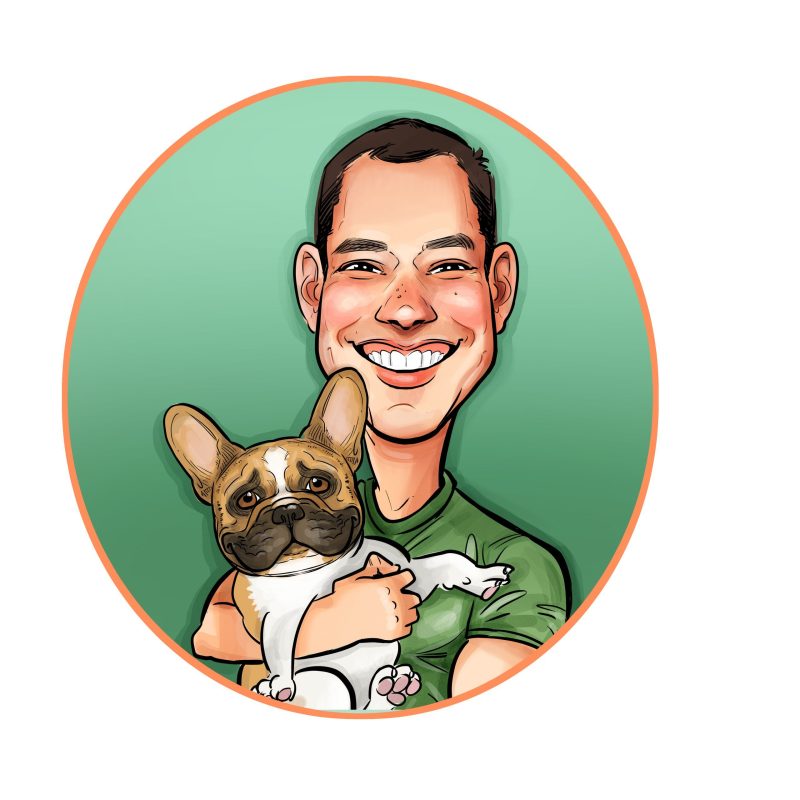If you were trying to draw a good likeness of Jon Casey’s face, you’d start with an oval standing on end.
The oval would be boxier than an egg, and slightly triangular at the bottom.
You wouldn’t draw age lines or creases — even at 39, Casey has a young, unlined, and cheerful face — but you‘d draw five light brown scribbles: two for his eyebrows, one for his thin mustache, and one, a crescent doodle just below his lower lip, to approximate his slightly threadbare soul patch.
The last scribble would go on the very bottom of his chin, like the tiny dollop of shading an artist uses to show a shadow where an apple sits on a table.
But even if you drew Casey’s face a thousand times, you would only have drawn a tiny fraction of the faces Casey has drawn.
Casey is a caricature artist, and he has been caricaturing for a living since he was 16.
For many Americans, the only piece of original art they own is a caricature, according to Celestia Ward, a caricaturist based in Las Vegas.
Ward says that caricaturists fall into different “strata,” although she says it is more a continuum than a strict hierarchy.
At the bottom, there are the artists who work on the street, frequently near tourist attractions. They may have a permit, or they may draw looking over their shoulders for the cop who will give them a citation. They carry their gear — a signboard with examples of their work, a satchel of drawing materials, an easel and two stools: one for the customer, one for the artist.
They work outside and, if the sun is blazing, they may tote a beach umbrella. They get their work from tourists and day-trippers, couples on a first date, families with young children, conventioneers still wearing their credentials.
A drawing may take 10 minutes and will bring in 10 or 12 bucks, more if the customer wants a body as well as a face, and more again if he or she wants color. It’s a cash business, and the artist eats only what he or she kills.
Next up are the artists who work in cartooning booths at theme parks and event locations — Disney World, Universal, SeaWorld. They have a fixed location, and the booth owner often handles the logistics of promoting the booth and stocking an inventory of art supplies and frames and stools and umbrellas.
These artists get hired by booth owners by showing their portfolio of colorful drawings of pimply boys with huge noses or teenage girls with long, long necks and lips that look as if they were filled with a tire pump. The artists work on commission, and while a booth in a bad location is a waste of time, a well-located booth can support a number of artists, all shouting at passersby, hawking their work at the same time.
Another tier are those artists who work birthday parties, weddings, bar mitzvahs and the like. These caricaturists often have the luxury of working indoors. They get paid by the hour or by the event, and they are free from the humbling need to solicit tourists slurping rum punches as they stroll the boardwalk.
The next tier, close to the top, are those artists whose work has gotten enough traction for them to be hired by corporations to draw caricatures at corporate off-sites, conferences and celebrations.
These artists work closely with event planners and will spend dozens of hours before the event begins, coordinating with the client about how to conduct the work and whether there will be a theme reflected in the individual drawings. To do this work, “you cannot show up in flip-flops 10 minutes late. You have to be on the mark. You have to make your corporate clients feel comfortable that they’ve hired you,” Ward says.
The payoff is that corporate work pays better — way better — than hustling 10-buck drawings on the boardwalk. In a couple of hours, an artist with a good corporate gig will make as much as he or she would make after baking in the sun selling sketches for 12 hours.
In his 24 years as a professional caricaturist, Casey has worked in each of the tiers, and now with the world flipped upside down by COVID-19, he is pioneering a new tier — virtual caricaturing.
Casey grew up in Ashland, Va., half an hour from Richmond. He was a quiet kid, always carrying a sketchbook. He drew all the time, everywhere. “By the time I got into high school,” Casey says, “I was sleeping or drawing in my classes. I wasn’t a great student.”
When he was 15 years old, he got summer work at the Kings Dominion theme park near his hometown. He cleaned bathrooms; it was not a prestigious job and not much fun. The kids that looked like they were having fun were the college students who worked at the caricature booth.
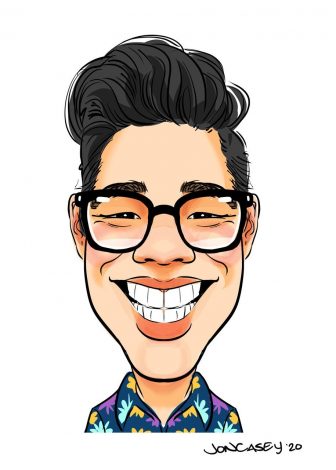
Casey wandered over and introduced himself. He started hanging around. The college students looked at his drawing and encouraged him. They didn’t teach him to draw because, Casey says, “The only way to really learn to draw is just to do it.” But they took him under their wing and let him visualize the possibility of making a living by drawing.
The next summer, Casey was in the booth.
In his first couple of days on the job, he drew people for practice and gave them his sketches for free. Then one day, he was at the booth, and his supervisor “went to take a lunch break and he just never came back.” Casey called the main booth for guidance. They said, ‘Yeah, it’s your booth now. Get to work.’”
At first, the work was “very, very intimidating.” Casey had to draw the subject on the spot and entertain them while he did. The drawing had to delight them. That was a hard-enough mission, but he had to do it right in front of the customers where they could watch his every move. And worse, there were always gawkers who came up and stood behind him, sometimes kibitzing and laughing and asking questions as he worked. He also had to work fast. He got paid on commission and, if he was slow, the economics, such as they were, didn’t work.
It was nerve-wracking, but a great way to get experience.
He went to college to study art, and for a while, he was focused on painting and printmaking, but when he graduated, he headed to San Diego where the college kids from Kings Dominion were working a booth at SeaWorld.
SeaWorld was one of the top locations in the country for caricaturing. It was a “very high-pressure environment,” Casey remembers. He says he was “typically in the top two or three for the day of sales.
But what that meant is that we were to work 12-hour shifts without taking lunch breaks — battling the artists next to you to see who would get the next person to sit down.” He says, “It was friendly competition, but it was pretty cutthroat.”
In 2005, Casey moved to San Francisco. After the intensity of SeaWorld, he thought he was done with caricaturing for a while. He got a job at a shoe store, but it didn’t pay enough to make rent. So, he decided to get his gear and head to Fisherman’s Wharf and hustle for customers out on the street.
The experience he had in the booths was good training. You needed two things on the street: You had to draw well, and you also had to be able to sell. He had “to get people to sit down.” He learned “to talk to different groups of people based on how they looked at their family, how to approach them. That became a whole other gamified aspect of the job.”
There was a lottery for legal spots at the wharf, but Casey thought the lottery locations were mostly bad. He found a place he liked just past Pier 39 where there was good foot traffic and lots of other illegal street artists and performers. There “would be DJs or spray-paint artists” as well as the “three-card Monte people.”
He made more money there in two hours or three hours than he could make in a day in the legal spots, but it was dangerous. Some of the other performers were really aggressive. “One of the last times I ever worked down there, someone was stabbed in the eye right in front of me, just buried the blade in their face,” he recalls.
It could also get “very windy and cold in the afternoon, and you are sitting outside all day. It beat down on you.”
He worked the wharf for three years, and that’s when he got a big break.
It was 2009, and Doug Donnellan and Frank Celaya, general manager and customer relations manager respectively of San Francisco Toyota, were looking for an artist to draw at a beer-and-holiday party at their dealership. They saw Casey’s work at the wharf and hired him.
Celaya remembers, “He was such a hit that first year. We invited him back and then we just kept inviting him back and back. We now are almost a 200-associate company. And he brings help because people come back multiple times, one by themselves or the kids wanting one by themselves or with their friends. He’s really popular.”
Casey liked the experience of doing a corporate party. He said, “Wow, this is a lot better than being down at the wharf. I get to charge by the hour, and in two or three hours, I make what would take a whole day at the wharf.”
He threw himself into getting more corporate gigs. He was working “12-18 hours a day sometimes, getting on Craig’s List, posting my work, posting it everywhere I could online, building websites, pushing events.”
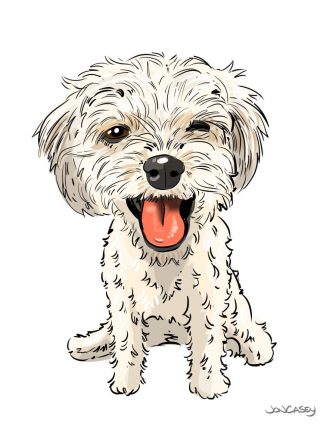
And it worked. “The first year that I started this business, my rates were low and I was really eager to work,” he says. “And I got a lot of it.”
One thing that helped was he began to work digitally. Casey says that there were only a handful of caricaturists at that time, 2008, working in digital format. iPads were not around yet, and the equipment was expensive and bulky. He estimates that he “probably spent $10,000-$15,000 ordering different things to try to figure out how I could draw digitally at events.”
He saw it as a great opportunity. He could really bring in color. “It’s very hard to do color on paper using color sticks,” Casey says. “They’re like compressed colored pencils. After hours of using them, your hands are cramped up. They look chalky and terrible on the drawing.”
Once Casey started to work in the digital format, his business took off. He was on the road all the time. He worked in London and Spain. Out of “52 weeks out of a year, 35 of them I was traveling around the country for events. Companies were paying me to go to Canada multiple times a month, putting me up in hotels, paying for my travel and then paying me to draw at their events,” he says.
He started to get work from companies like Google, Cisco and Symantec. Sometimes there was so much work at an event that he had to bring a team of caricaturists. “I became kind of the ringleader for booking caricaturists in the Bay Area,” Casey says. “I could bring three artists or 15 artists to an event if it was big enough.”
He remembers one event where the tech company client projected the image he was drawing up on 20- or 30-foot-high screens so all the people at the event could see their colleagues being drawn.
The business grew and prospered. Casey loved the work, and it was gratifying how much his clients liked his drawings. “I started telling people my goal is to have a drawing on every person’s fridge in the Bay Area,” he says.
Then COVID-19 arrived.
In late February, Casey was drawing at a large trade show, and he noticed that attendance was way down. Then a big South Korean company pulled out. “By the end of that show, it was clear that things are really going to change,” he says.
When he got home all that greeted him were cancellations. “Just every day I was getting cancelation emails,” he says. “That was terrifying.”
The business came to a full stop. “Even during the financial crisis in 2008, people still got married and ha[d] birthday parties,” Casey says.
“I thought that even in the slowest of times, I’d be able to get by. I couldn’t imagine anything that would just completely put a stop to all the ways I was used to making a living.”
But it did.
When the shelter-in-place orders went into effect in March, Casey thought he could hunker down, live off his savings, and the pandemic would pass in a few months. By the holiday season, he’d be up at it, working full time.
But that was wishful thinking. The pandemic wasn’t going away.
Casey has always been hard-working; as an artist-entrepreneur he had to be. And after being hunkered down for two weeks he couldn’t stand doing nothing. He started to advertise that he’d draw your pet for $25. “I probably did 75 or 100 pet sketches.”
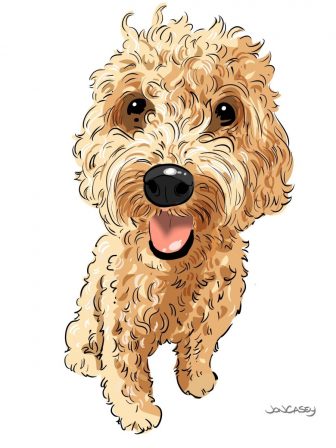
Then he started to market to his old clients and offer to draw posters of their corporate teams. People liked that idea, and he got some work, but it was a small percentage of his former income.
Then something interesting happened.
Casey had been wondering if there was a way he could take the live corporate-event drawing he had been doing into the virtual space. Corporations were still working, though remotely. Team members were getting together every day on Zoom. Why couldn’t he caricature people in their virtual space?
Kellie Cash, an event planner at Atlassian, an Australian tech company with a San Francisco office, reached out to Casey. Cash was organizing an internal event on May 4, Star Wars Day (“May the Fourth be with you”). Casey had drawn an event in person for Atlassian in 2018, and his work had been very popular.
The COVID lockdown was well underway, and Cash and her team “were just trying to think of any way possible to incorporate our vendors that we use for normal events and try to get them some business.” Cash remembered how much their people had liked Casey and reached out to ask him if he could draw a virtual Star Wars-themed event.
Initially, it was going to be a small thing, just a couple of hours of drawing, no big deal. But when the company put out a sign-up sheet on their internal servers, “it just exploded,” Casey says.
The job got so big that ultimately Casey brought in 12 artists, and they were “drawing pretty much continuously for three days. We drew through the night for people in Spain and India. And then the next morning, [we were] back up, drawing people in the U.S. with this huge team of artists,” Casey says.
The artists were put in separate Zoom rooms and “every 15 minutes another person from somewhere else in the world would jump in on our Zoom link, and we would draw them,” Casey says.
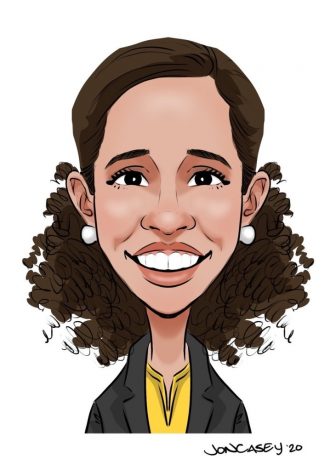
It was his first experience drawing a virtual event, but it worked very well. And there were some advantages. He could draw people all over the world. He didn’t have to lug his equipment to another city. He figured out how he could pin a live view of him drawing the subject into a Zoom window. What he had done in person for years “translated to virtual life almost flawlessly,” he says.
The event proved a big hit for Atlassian. “People were kind of twiddling their thumbs at their homes,” Cash says. “How do we engage each other with each other even though we’re not physically together? It’s hard to do that over Zoom. But the special part about this one was the fact that everyone wanted to get their roommates involved, wanted to get their families involved, and they wanted to, you know, just to be able to watch someone draw something like that.”
Cash contacted another company where she had a friend, and they also hired Casey. Then, a bunch of East Coast universities were looking to do something fun for their students in lieu of their typical welcoming events. Casey and a friend from Florida worked for dozens of colleges “where people would just pop in on the Zoom room, and we’d draw them and send it to them,” he says.
He found that with Zoom you could schedule people in 15-minute slots. That was enough time to make sure the light was OK and have a little chat with the subject. That felt like a luxury because at a live corporate event or trade show there was often a deep line of people waiting for their portrait and the pressure was to move very fast to get to the next person.
He also realized that he could work a virtual event with caricaturists all over the world. He recently had one of the “greatest caricaturists alive,” Jan Op De Beeck, an artist living in Holland, jump into an event and do some drawing.
There were downsides, too. Some people have cheap cameras when they Zoom or sit in rooms with bad lighting, windows behind their heads, their faces washed out. Sometimes, he has to work from screenshots, and if the resolution is blurry and the subject is looking down at his or her keyboard, the drawing is not going to fix that.
Casey doesn’t know where this new virtual business is going; it is too early to tell. “I feel incredibly lucky that I have gotten some of the virtual jobs I had,” he says.
But the future is still uncertain.
“I think we could be working more doing this than we ever have before,” Casey says. “If we can do events anywhere in the world for any client. Doesn’t matter what time it is [where] they’re located. But I have no idea how to get them all aware that it’s even an option. And building that up is really scary right now.”
There is also one thing about live caricaturing that will be hard to replace. “It’s very strange when you create this intimate setting where you’re in physical proximity to someone, and you have the ability to stare at their face, which at any other point in your life is frowned upon and awkward,” he says. “And you get to ask them some personal questions. I’ve had people really open up to me. You know, they feel vulnerable. And they also feel like, hopefully, that you’re taking care of them.”
* If you’re interested in Jon Casey’s caricature work, find him at Cartoon.Guru.
